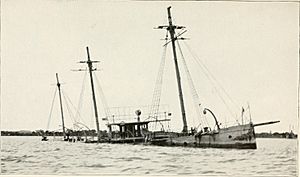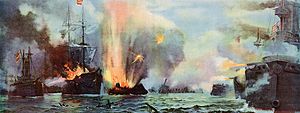Spanish cruiser Don Antonio de Ulloa facts for kids

Don Antonio de Ulloa, at the Battle of Manila Bay, 1 May 1898
|
|
Quick facts for kids History |
|
|---|---|
| Name | Don Antonio de Ulloa |
| Namesake | Antonio de Ulloa |
| Builder | La Carraca shipyard, Cadiz, Spain |
| Laid down | 1883 |
| Launched | 23 January 1887 |
| Completed | 1889 |
| Fate | Sunk 1 May 1898 |
| General characteristics | |
| Class and type | Velasco-class unprotected cruiser |
| Displacement | 1,152 tons |
| Length | 210 ft 0 in (64.01 m) |
| Beam | 32 ft 0 in (9.75 m) |
| Draft | 13 ft 8 in (4.17 m) maximum |
| Installed power | 1,500 ihp (1,100 kW) |
| Propulsion | 1-shaft, horizontal compound, 4-cylinder boilers |
| Sail plan | Barque-rigged |
| Speed | 13 knots (24 km/h; 15 mph) |
| Complement | 173 officers and enlisted |
| Armament |
|
| Notes | 200 to 220 tons of coal (normal) |
The Don Antonio de Ulloa was a Spanish warship, a type called an unprotected cruiser. It was part of the Spanish Navy and played a role in the Spanish–American War. This ship was built in Cadiz, Spain, starting in 1883 and launched in 1887. The Don Antonio de Ulloa also took part in fighting against Filipino rebels during the "Tagalog Revolt" from 1896 to 1897. During the Battle of Manila Bay, the ship was being repaired and could not move. It had fewer weapons and crew members, and was sunk with little resistance.
About the Ship
The Don Antonio de Ulloa was built at the La Carraca shipyard in Cadiz, Spain. Its construction began in 1883, and it was launched into the water on January 23, 1887. The ship was finished and ready for use in 1889. It had a tall funnel and was built with an iron hull. The ship was also rigged like a barque, meaning it had sails as well as an engine.
Ship's Journey and Service
On March 7, 1890, Captain Manuel de la Cámara took charge of a group of ships called the Philippine Division. This group included the Don Antonio de Ulloa and two other cruisers, the Castilla and the Don Juan de Austria. Their mission was to strengthen the Spanish Navy's squadron in the Philippines.
The division left Cádiz on April 9, 1890. They sailed through the Mediterranean Sea, the Suez Canal, and the Indian Ocean. They stopped in Barcelona, Port Said, Suez, Aden, and Colombo before reaching Singapore on June 2, 1890. The ships continued their journey the next day and arrived in Manila on June 17, 1890. In the Philippines, this group of ships became known as the "Black Squadron" because they were painted black, unlike other ships in the area that were white.
Later in 1890, the Don Antonio de Ulloa was sent from the Philippines to the Caroline Islands. This was to respond to threats from the German Empire to those islands, which Spain owned. The ship then returned to the Philippines to replace its sister ship Gravina, which had been lost in a typhoon in 1884.
In December 1890, Captain Cámara became ill and had to leave his command. After he left, the Don Antonio de Ulloa remained in the Philippines. It played an important part in Spain's military actions against Filipino rebels during the "Tagalog Revolt" (1896–1897). One of its key roles was transporting Spanish Army troops to Zamboanga in 1897.
The Battle of Manila Bay
By the spring of 1898, the Don Antonio de Ulloa's engines were in very bad shape and had to be removed for repairs. This meant the ship could not move. It was anchored off Cavite in Manila Bay. Some of its guns were also removed from the left side of the ship to help strengthen land defenses. This left the ship with only its right-side guns and about half of its crew, which was just enough to operate those remaining guns.
The ship was in this condition when the Spanish–American War began in April 1898. It was anchored with the rest of Rear Admiral Patricio Montojo y Pasarón's squadron in Manila Bay. Its spot was behind Sangley Point, where the Spanish hoped the low, sandy land would offer some protection to the ship's hull if the U.S. Navy attacked.
The U.S. Navy's Asiatic Squadron, led by Commodore George Dewey, attacked early on the morning of May 1, 1898. This was the Battle of Manila Bay. Dewey's ships made several slow passes, firing at the Spanish squadron. During the first pass, the Don Antonio de Ulloa was hit a few times. The worst hit was a large shell that exploded on the upper deck. This explosion killed nine men, including the ship's commanding officer, and wounded ten others. This left almost no one left to operate the ship's remaining guns.
There was also no one left to lower the ship's flag. When Dewey's squadron turned around for a second firing pass, they thought the still-flying flag meant the Don Antonio de Ulloa was still fighting. The U.S. squadron continued to hit the helpless ship, and it sank in shallow water. After the battle, it was found that the ship's hull had been hit by many shells of different sizes.
After the battle, a group from the American gunboat USS Petrel boarded the Don Antonio de Ulloa and set its wreck on fire. After the war, a U.S. Navy team checked the ship and found it could not be saved. Its remains were later taken apart for scrap.
See also
 In Spanish: Don Antonio de Ulloa (1883) para niños
In Spanish: Don Antonio de Ulloa (1883) para niños



